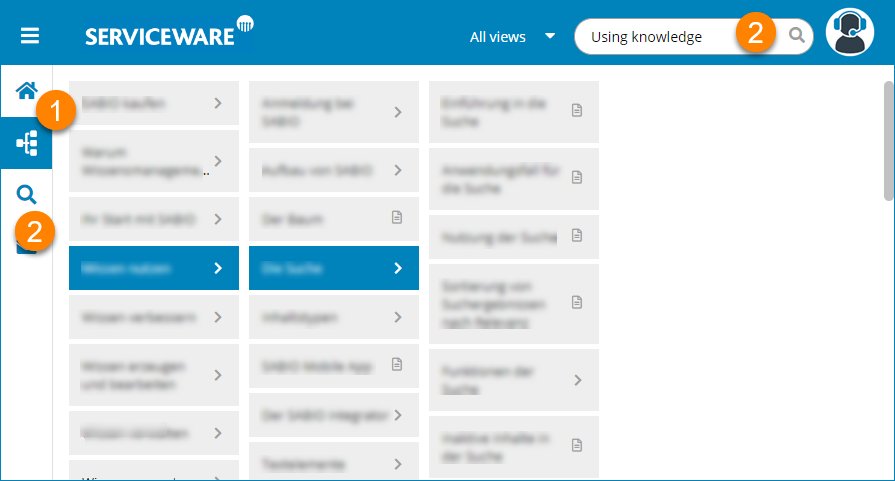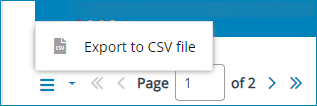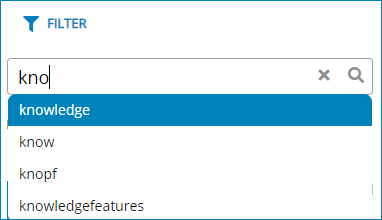Search function
The search function helps you find relevant content when navigation via the tree is not useful.

- Search via the tree; open the tree via the tree icon in the navigation menu. Move the mouse over a branch to see more branches and files.
- Search via the search function; open the search function by entering a term in the search field in the top bar or via the Search icon in the navigation menu.

| (1) | Search function in navigation menu | (2) | Filter function |
| (3) | Content list | (4) | Search content |
Entering a search term in the search field is supported by auto-completion. You can start the search from the search field in the top bar or within the search field. After starting the search from the top bar, the search window opens. It consists of the area for entering searches and filters, the content list with a brief overview and a window for displaying a selected text.
From the search function, you can limit the search to file types directly, or search across all content.
The short view of the hits includes title, read text and path. The user groups to which the hits are assigned are indicated by color dots below the path.
Relevant hits are highlighted in color in the content list. Both the exact search term and synonyms or related words that have the same root are highlighted. The title, content, tags and categories of a piece of content are taken into account. Contents can be texts, files, messages, contacts, templates, and external sources. The search term highlighting function is turned on by default and may be turned off via the settings in the Admin tab.
You can scroll to further search results in the footer of the content list.

Functionality of the search
- A search term should consist of at least 3 characters in order to be considered by the search.
- If you are searching for very short words or abbreviations – for example SMS – word string recognition may not work because no words are recognized. In this case, use quotation marks to search for the term as a phrase: SMS.
- A decompounder, which breaks down compound words into partial words and thus increases the hit rate, is available for the German language.
- The branches title are not considered in the search. If you want to make a branch title searchable, it must be tagged.
- To increase the retrieval of particularly long terms, you can use search suggestions from auto-completion. Entering Social sec offers the hit Social security contributions in the selection list.
- Use tags to improve the relevance of your texts – that is, their positioning in the hit list.
- For compound terms, specify the terms separately so the decompounder can recognize the root words: Social Security Contribution.
- Use wildcards, for example Social*contribution.
- Example: If you search for the term Social security contributions, no hits will be found for search terms Social or Social security.
Auto-completion

Auto-completion takes into account terms that appear in the title, content, tags and categories of knowledge content. Auto-completion starts as soon as the second character is typed in the search field by default. As you type more characters, the suggestion list is updated.
Auto-completion works for more than one term. After a first term is typed or selected from the list of suggestions, the consumer can start typing the next term after typing a space and benefit from auto-completion. Auto-completion only considers terms that occur in combination with the first term in knowledge content.
The auto-completion function is switched on by default and may be switched off by the administration via the settings.
The function Did you mean
The Did you mean? function in the search allows the correct content to be found in Serviceware Knowledge even though the consumer has entered the search term incompletely or incorrectly. This may be a case of typos or other minor spelling mistakes. This allows the consumer to save time, as the search will still find the desired results.
The function Did you mean? is triggered when no results are found by the search for the entered term, but there are results for a term that is very similar to the original search term. If no similar term exists, the function Did you mean will not return any results either.
By default, the function Did you mean is enabled for the search. If you do not want to use it, the function can be disabled in the search settings by Knowledge support.
| Operator | Description |
|---|---|
| * | If the search does not find any results that match the string before or after the wildcard operator, the function Did you mean? is triggered. |
| "" | If no match with the phrase search is found, the function Did you mean? is triggered. |
Search in tags
In order to find a text even if the entered search term is not contained in its content or title, each text can be tagged. These are entered as individual words, separated by commas, in the tag field of each text.
The following behavior is defined with respect to special characters:
- The input is carried out as single words without spaces.
- No distinction is made between upper and lower case.
- Spaces before or after words are automatically removed when the text is saved.
- Double spaces are replaced with a single space.
- Special characters are removed when saving the text, except for underscores.
